|
Chorale Melodies used in Bach's Vocal Works
Ich ruf zu dir, Herr Jesu Christ |
|
Melody & Text | Use of the CM by Bach | Use of the CM by other composers |
| |
|
Melody & Text: |
|
"Ich ruf zu dir, Herr Jesu Christ". [Supplication.] Wackernagel, iii. pp. 54-55, gives two forms of this, in 5 stanzas of 9 lines, the first from Geistliche Lieder, Erfurt, 1531, the second from an undated broadsheet before 1530, entitled, "A new hymn of supplication for Faith, Love, and Hope, and for a Holy Life; composed by John of Eisleben, preacher to John Duke of Saxony." Fischer, i. 345, refers to the Nürnberg broadsheet, c1526, quoted in Wackernagel's Bibliographie (1855), p. 89, and adds that in his opinion the disfavour into which Johann Agricola fell after the outbreak of the Antinomian controversy caused the suppression of his name in the hymn-books. After appearing in Klug's Geistliche Lieder (1529), the hymn was included in almost all subsequent hymn-books, and so recently as No. 379 in the Unverfälschter Liedersegen (1851).
It is sometimes erroneously ascribed to Paulus Speratus, an assumption originating with the Riga Gesang-buch of 1664. It was a favourite hymn of Valerius Herberger, of P. J. Spener (who requested it to be sung at his deathbed), and of many others.
Source: John Julian: Dictionary of Hymnology (1907) on Hymnary.org |
|
"Ich ruf zu dir Herr Jesu Christ" (I call to you, Lord Jesus Christ) in the Neu Leipziger Gesangbuch (NLGB 627) is one of the most ubiquitous Trinity Time chorales. The Johann Agricola ?1529 five-stanza chorale is assigned in the NLGB as the Hymn of the Day for the Second, 19th and 21st Sundays after Trinity and as a communion hymn on the Sundays after Trinity +5, +6, +8, and +22. J.S. Bach chose "Ich ruft zu dir, Herr Jesu Christ" as the subject of Chorale Cantata BWV 177 (BCW Discussion June 26), for the Fourth Sunday after Trinity, presented in 1732, to fill that service gap in Cycle 2. J.S. Bach also uses the first stanza as the closing chorale with violin obbligato (No. 6) in Cantata BWV 185, "Barmherziges Herze der ewigen Liebe" (Merciful heart of love everlasting [by Richard Stokes]), premiered in Weimar in 1715 and possibly repeated in 1716, in Leipzig in 1723 and 1746-47. During the pre-Cantata Cycle 3 Trinity Time of 1725, a libretto book shows that for the Third Sunday after Trinity, June 17, the entire chorale is printed as a pure-hymn cantata but is not related to Cantata BWV 177. It is also listed as the NLGB Hymn of the Day for the Third Sunday After Epiphany <omne tempore>ordinary time, as well as for Septuagesimae and Sexagesimae Sundays before Lent. The melody of Johann Agricola's 1529 five-verse hymn appears as a chorale prelude in the Orgelbüchelin (No. 91), BWV 639, in the fifth <omne tempore> listing of 26 after the Catechism, under the heading "Christian Life and Conduct." Its variant setting is BWV Anh.II 73.
Source: Motets & Chorales for 4th Sunday after Trinity (William L. Hoffman, June 22, 2011) |
|
Melody: Zahn 7400
Composer: Anon: Hagenau (1526/1527), Wittenberg (1529) |
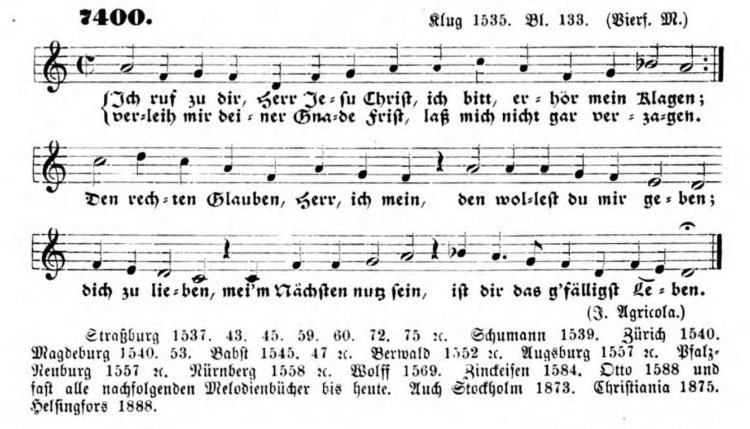 |
|
Text: Ich ruf zu dir, Herr Jesu Christ (NLGB 235; GH 299; EG 343; KGEL 273)
Author: Johann Agricola (1526/1527) |
|
Hymnal versions Bach may have known: |
|
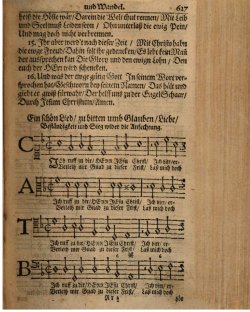
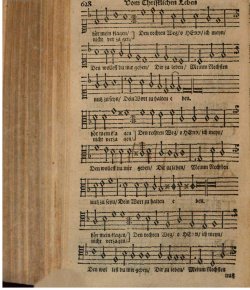

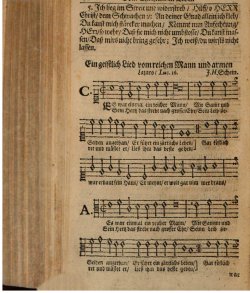
|
|
Melody & text of In dich hab ich gehoffet, Herr (NLGB 254) from the Neu Leipziger Gesangbuch (1682), pp 627-630 |
|
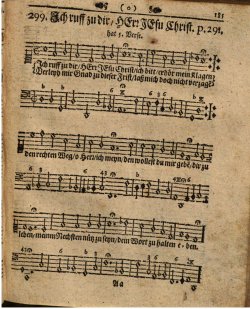
|
|
Melody & verse 1 of In dich hab ich gehoffet, Herr (GH 299) from the Gotha Humnal (1715), pp 185 |
| |
| |
|
Use of the Chorale Melody by Bach: |
|
Text: Ich ruf zu dir, Herr Jesu Christ |
|
Chorus Ich ruf zu dir, Herr Jesu Chris (Mvt. 1) from Cantata BWV 177 (1732) (verse 1) |
|
Form. Choral Fantasia (2 Ob., Violino concertante, Strings, Continuo). |


 |
|
Chorale Ich lieg im Streit und widerstreb (Mvt. 5) from Cantata BWV 177 (1732) (verse 5)
Ref: RE 71 (down a m3); Br 71 (down a m3); Birnstiel 69; Di 67; Levy-Mendelssohn 51; Fasch p.106 (down a m3) |
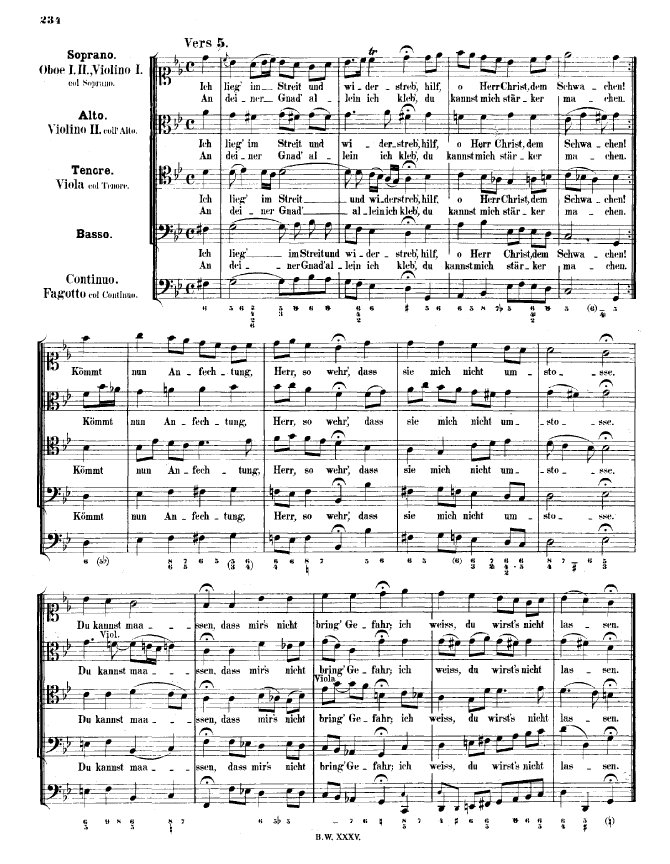 |
|
Chorale Ich ruf zu dir, Herr Jesu Christ (Mvt. 6) from Cantata BWV 185 (1715) (verse 1)
Ref: Di 68 |
|
Form. Embellished (Tromba, Oboe, Fagotto, Strings, Continuo). Choralgesange, No. 184. |
 |
|
Chorale Ich ruf zu dir, Herr Jesu Christ, BWV 1124
Ref: Di 69; AmB 46II p.279 |
 |
|
Untexted: |
|
Chorale Prelude Ich ruf zu dir, Herr Jesu Christ (I), BWV 639 (Orgelbüclein) (1713-1715) |
|
The movement is the only completed number in the “Christian Life and Experience” section of Part II of the Orgelbuchlein. It may be conjectured that, when he wrote it, J.S. Bach had before him particularly the first stanza of the hymn. His treatment of the melody of the first two lines of the stanza conveys a wistfulness of appeal that may have been suggested by the words
Lord, hear the voice of my complaint,
To Thee I now commend me.
Underneath this petition the Pedal asserts a firm and confident rhythm which seems to express the
True faith from Thee, my God, I seek
of the fifth line, and may be compared with the steadfast procession of Pedal crotchets in the “Credo in unum Deum” of the B minor Mass, which symbolizes the unshakable solidarity of the Church’s faith. |
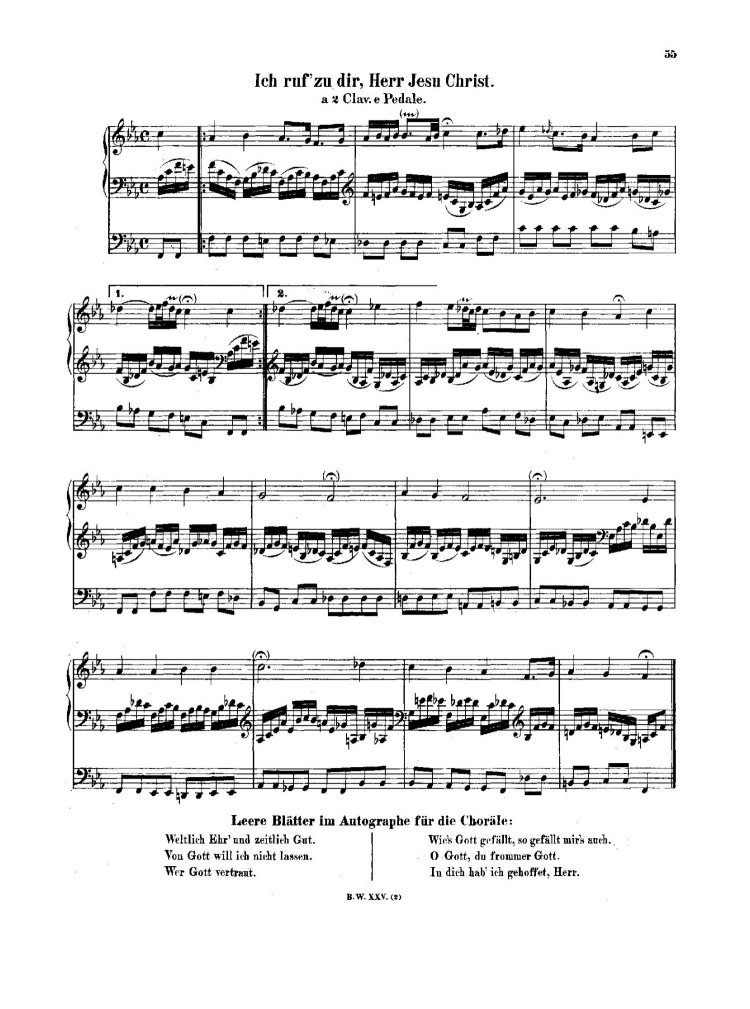 |
|
Chorale Prelude Ich ruf zu dir, Herr Jesu Christ (II), BWV deest |
| |
| |
| |
|
Use of the Chorale Melody by other composers: |
| |
| |
|
Sources: Bach Digital; BGA; Zahn; BCML discussions on BCW; Charles Sanford Terry's Bach Chorals books
Photos from Gottfried Vopelius: Neu Leipziger Gesangbuch (Vopelius 1682) & Christian Friedrich Witt: Psalmodia Sacra, Oder: Andächtige und schöne Gesänge… (Gotha Hymnal, 1715), were taken from digital copies of the books downloaded from Bayerische Staatsbibliothek München. These copies are Out of copyright - non commercial re-use (Europeana Rights).
Prepared by Aryeh Oron (October 2018) |